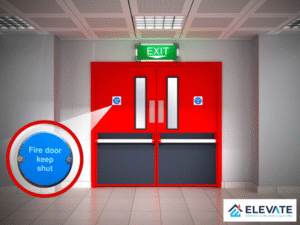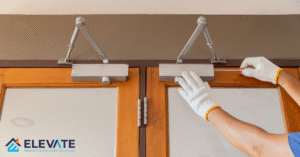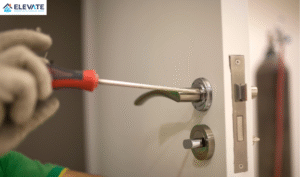Understanding Fire Door Materials and Their Role in Fire Protection
Fire doors are a critical line of defence in any building’s fire safety strategy — but what exactly are fire doors made of?
From high-performance cores to heat-expanding seals, every component of a fire door is carefully designed to withstand intense heat, block smoke, and protect escape routes.In this article, we’ll break down the most common fire door materials, explain their purpose, and help you understand what makes a door fully compliant with UK fire safety standards.
What’s Inside a Fire Door? (Core Materials)
At the heart of every fire door is a fire-resistant core. The core provides the main barrier to fire and heat, and its material can vary depending on the door’s rating and application.
The most common fire door core types include:
🔸 Solid Timber Core
- Traditional and very durable
- Layers of hardwood or softwood
- Heavy and robust
🔸 Particleboard or Chipboard Core
- Made from compressed wood particles
- Cost-effective and widely used
- Often found in 30–60 minute fire doors
🔸 Mineral Core
- High-density and highly fire-resistant
- Often used in FD60+ doors
- Includes gypsum, calcium silicate, or vermiculite boards
🔸 Honeycomb Core (in lower-grade doors)
- Not typically used in certified fire doors today
- Offers limited fire resistance
- Avoid unless fully certified
The type of core greatly impacts the fire-resistance rating — typically FD30 (30 minutes) or FD60 (60 minutes).
What Else Are Fire Doors Made Of?
Besides the core, compliant fire doors include essential materials that help them seal and function during a fire:
🔹 Intumescent Seals
- Strips fitted around the edges
- Expand when heated to seal gaps
- Prevent smoke and flames from spreading
🔹 Smoke Seals (Cold Smoke Seals)
- Flexible brushes or blades
- Block the passage of smoke before the intumescent expands
🔹 Face Veneer or Laminate
- A decorative or protective surface (e.g., hardwood veneer, laminate)
- Doesn’t affect fire resistance, but adds durability
🔹 Glazing (If Applicable)
- Fire-rated glass (e.g., Pyrostop, Pyrobel)
- Must be set in intumescent glazing seals and tested as part of the door set
🔹 Hardware (Ironmongery)
- Must be fire-rated: hinges, latches, closers, locks, etc.
- Incorrect hardware can compromise the whole door’s performance
Certification and Compliance
A fire door is only compliant if it has been tested and certified as a complete set — including the door leaf, frame, seals, glazing, and hardware.
Look for:
- A certification label or plug (e.g. BWF-CERTIFIRE)
- FD30 / FD60 marking
- Manufacturer details
- Installation by a competent person
Why the Materials Matter
The right fire door materials:
- Contain fire and smoke for 30–60+ minutes
- Protect escape routes
- Comply with UK law under the Regulatory Reform (Fire Safety) Order 2005
Non-compliant or damaged materials put people at risk — and expose building owners to legal consequences.
Need Help Checking Your Fire Doors?
At Elevate Safety Solutions, we carry out:
- Certified Fire Door Inspections
- Remedial work and upgrades
- Installation of fully tested fire door sets
We’ll make sure your fire door materials — from the core to the hinges — are 100% compliant.






